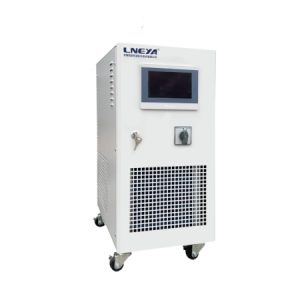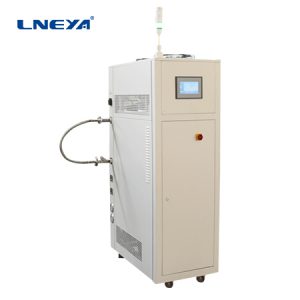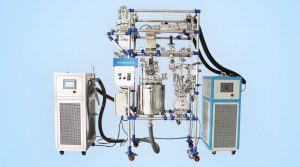Microscopio electrónico de barrido Sistema de circulación de agua de refrigeración
Scanning Electron Microscope (SEM) is a high-resolution microscope widely used in materials science, biology, nanotechnology and other fields. SEM generates a certain amount of heat during operation. In order to ensure the stable operation and image quality of the microscope, an efficient cooling water circulation system is required to control the temperature inside the SEM.
The following are the key components and working principles of the cooling water circulation system of the scanning electron microscope: Key components:
- Circulation pump: responsible for promoting the circulation of cooling water in the system to ensure that the cooling water can flow evenly through various cooling points inside the SEM.
- Cooling water tank: stores cooling water, usually contains filters and chemical additives to maintain the purity of cooling water and prevent corrosion.
- Heat exchanger: transfers the heat in the cooling water to the external cooling medium (usually air or water) through the heat exchanger to achieve the purpose of cooling.
- Temperature controller: monitors the temperature of the cooling water and adjusts the temperature of the cooling water through automatic control systems such as PID controllers to ensure that it is stable within the set temperature range.
- Filter: Filter impurities in cooling water to prevent clogging of the cooling system.
- Pipes and valves: Connect various components to ensure that cooling water can circulate smoothly.
Working principle:
- Cooling water circulation: Cooling water flows out of the cooling water tank and enters the cooling channel or cooling plate inside the SEM through the circulation pump to absorb the heat generated inside the SEM.
- Heat exchange: The cooling water that has absorbed heat then flows into the heat exchanger, where the heat is transferred to the external cooling medium through the heat exchanger to achieve cooling of the cooling water.
- Temperature control: The temperature controller continuously monitors the temperature of the cooling water and adjusts the speed of the circulation pump, the flow rate of the cooling water or the working state of the heat exchanger as needed to keep the temperature of the cooling water stable within the set range.
- Circulation reflux: The cooled cooling water returns to the cooling water tank again to prepare for the next cycle.
- Filtration and maintenance: After a period of use, the cooling water needs to be filtered to remove impurities, and the cooling water and chemical additives need to be replaced regularly to keep the system clean and efficient.
Key requirements:
- Temperature control accuracy: It is usually necessary to control the temperature of the cooling water within the range of ±0.5°C to ±1°C to ensure the stability of the temperature inside the SEM.
- Circulation efficiency: Ensure that the cooling water can circulate efficiently to avoid local overheating. • Safety and protection: The system should have safety measures such as over-temperature protection and pressure protection to ensure the safe operation of the equipment.
- Low noise: The circulation pump and heat exchanger should reduce noise as much as possible to avoid interference with the operation of the SEM.
- Maintenance convenience: The design should be easy to maintain and clean to ensure long-term stable operation.
In summary, the cooling water circulation system of the scanning electron microscope ensures the stability of the temperature inside the SEM by accurately controlling the temperature of the cooling water, thereby improving the imaging quality and stability of the microscope.
Recomendaciones relacionadas
-
What tests are used by cooling water chillers for new energy enterprises?
918In the process of product development, production and quality control, new energy enterprises will use cooling water chillers to perform a variety of tests. Cooling water chillers play an important role in these tests to ensure the perform...
Ver detalles -
What instruments in biopharmaceutical processes require cooling water systems?
835In biopharmaceutical processes, many critical equipment and instruments require cooling water systems to maintain their normal operation and process temperature control. The following are some common types of equipment that require cooling w...
Ver detalles -
Refrigeration Unit Water Cooling Chiller
777The chiller water cooling system is an efficient cooling solution that removes heat by circulating cooling water. This system is widely used in industrial, laboratory and commercial environments, especially in applications that require precis...
Ver detalles -
Distillation tower process chiller heating system
1060Distillation towers and distillation tower processes indeed require chillers and heating systems to maintain temperature control during the process, ensuring effective separation and purification operations. The top temperature of the ...
Ver detalles -
Way to Check Problems of the Lubricating Oil System of the Screw Chiller Factory
966Everyone pays more attention to the refrigerant circulation system and the chilled water circulation system of the screw chiller factory operation system. However, lubricating system is often neglected by everyone. In fact, this system of cold wat...
Ver detalles -
Sistema integral de pruebas de motores de automóviles de nueva energía
1118When the LNEYA new energy vehicle motor integrated test system is running, the control panel settings are required. At the time of setting, if the user does not know how to use it, you can check the manual for use. The indicator of the new energy ...
Ver detalles -
Precautions for the use of explosion-proof single fluid refrigeration heating temperature control de
1001There are many types of reactors, and laboratory reactors are one of them. What is the point of attention of LNEYA reactor temperature control system-explosion-proof single-fluid refrigeration heating temperature control device? The temperature me...
Ver detalles
 LNEYA Enfriadoras industriales Fabricante Proveedor
LNEYA Enfriadoras industriales Fabricante Proveedor













